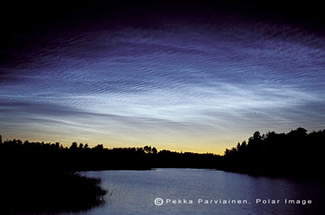 by Doug Schneider August 10, 2003
Getting the space shuttle into space is no easy task. The shuttle rides atop a silo-sized fuel tank that supplies the shuttle's three main engines with more than 700 tons of liquid hydrogen. During its launch from Florida's Kennedy Space Center, the shuttle trails a massive plume of exhaust as it pushes through the earth's atmosphere. Mike Stevens a physicist with the U.S. Naval Research Laboratory in Washington, D.C. said, "You can think of it as essentially a long garden hose that is on the order of 1,000 km long, and it equilibrates to the ambient pressure and temperature and expands to a diameter of approximately 3 km. And this is at an altitude of approximately 110 km." Stevens says scientists at
first didn't think much about the shuttle's exhaust, since it's
mostly just water vapor. But then they noticed that within a
day following a shuttle launch, a large plume of water vapor
appeared high over the Arctic. They also noticed that within
a week or so, rarely seen formations of thin, wispy, cloud called
PMCs-that's short for polar mesospheric clouds-appeared over
Canada and Alaska. Mike Stevens has been studying the shuttle's launch exhaust, the vapor plume and the mysterious cloud formations, and he says they're all connected. Stevens said, "We have an observation of a large plume of water vapor in the Arctic about a day after a shuttle launch. At the end of the mission about a week later we see a range of PMCs appear over northern North America, including Alaska. And then the third piece of evidence is, we calculated how much water is sequestered in these ice clouds, these polar mesospheric clouds, and we compared that to the amount contained in the shuttle plume, and the numbers were nearly equivalent." Stevens said scientists haven't completely figured out just how the shuttle's exhaust ends up in the Arctic, but he says it probably happens something like this: Winds as high as 55 miles above the earth, within the outermost layer of the atmosphere called the thermosphere, whisk the shuttle's exhaust northward. As the vapor plume falls back toward
Scientists have another name for these clouds. They call them noctilucent clouds. But don't dash outside and try to see them. They're too thin to be seen by the eye during the day. But after the sun has set, noctilucent clouds tend to shine as the sun's rays hit them from just below the horizon. Now it also should be pointed out that noctilucent clouds can form without the help of the space shuttle. In fact, such clouds were first documented back in 1885. But lately, it seems the mesosphere has had more than its share of noctilucent clouds. Mike Stevens wonders if using rockets to launch everything from the shuttle, satellites and space probes might have something to do with it. Stevens said, "What remains to be done is to untangle the contribution to the PMC record from rocket launch vehicles." According to Stevens there are some good reasons for scientists to learn more about polar mesospheric clouds. "Well, what I hope it will do is invite researchers to look at their data in a new way. Because we are suggesting that the water, at least some of the time, is coming from above to create these clouds, rather than what is conventionally thought that it is coming from below," said Stevens At the moment, scientists have
no reason to believe that the shuttle's exhaust causes anything
other than the formation of noctilucent clouds. And while the
Space Shuttle Program has been grounded since the February 1st,
2003, explosion of the shuttle Columbia that killed seven
astronauts, any future launches will likely be closely followed
by scientists trying to bring their understanding of the atmosphere
back down to earth.
Story & photos courtesy of:
|
|||

